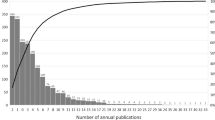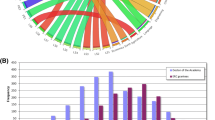Abstract
Age effects in scientific production are a consolidated stylised fact in the literature. At the level of scientist productivity declines with age following a predictable pattern. The problem of the impact of age structure on scientific productivity at the level of institutes is much less explored. The paper examines evidence from the Italian National Research Council. The path of hiring of junior researchers along the history of the institution is reconstructed. We find that age structure has a depressing effect on productivity and derive policy implications. The dynamics of growth of research institutes is introduced as a promising research field.
Similar content being viewed by others
References
H. A. SIMON, Models of Man, John Wiley and Sons, NY (1957).
R. K. MERTON, The Matthew effect in science, Science, 159 (1968) 56-63.
P. D. ALLISON, J. A. STEWART, Productivity differences among scientists: evidence for accumulative advantage, American Sociological Review, 39 (4) (1974) 596-606.
S. G. LEVIN, P. E. STEPHAN, Research productivity over the life cycle: evidence for academic scientists, American Economic Review, 81 (1) (1991) 114-132.
S. AVVEDUTO, Human resources in science and technology, paper presented to the CISS Moncalieri Workshop, December 11, 2002.
European Commission, Second European Report on S&T Indicators, Luxembourg, 1997.
F. NARIN, Bibliometric techniques in the evaluation of research programs, Science and Public Policy, 14 (1987) 99-106.
F. NARIN, D. OLIVASTRO, K. A. STEVENS, Bibliometrics-Theory, Practice and Problems, Evaluation Review, 18 (1994) 65-76.
Y. OKUBO, Bibliometric indicators and analysis of research systems: methods and examples, STI Working Papers 1997/1, OECD, (1997) Paris.
N. MULLINS, W. SNIZEK, K. OEHLER, The structural analysis of a scientific paper, In: VAN RAAN A. F. J. (Ed.), Handbook of Quantitative Studies of Science and Technology, pp. 81-105, North Holland, Amsterdam (1988).
Bureau of Industry Economics, Australian Science: Performance from Published Papers, Australian Government Publishing Service, Canberra, 1994.
E. GARFIELD, A. WELLJAMS, A. DOROF, Citation data: their use as quantitative indicators for science and technology evaluation and policy making, Science and Public Policy, 19 (1992) 321-327.
J. A. D. HOLBROOK, Basic indicators of scientific and technological performance, Science and Public Policy, 19 (1992) 267-273.
J. A. D. HOLBROOK, Why measure science?, Science and Public Policy, 19 (1992) 262-266.
R. N. KOSTOFF, Performance measures for government-sponsored research: overview and background, Scientometrics, 36 (1994) 281-292.
A. SCHUBERT, T. BRAUN, Relative indicators and relational charts for comparative assessment of publication output and citation impact, Scientometrics, 9 (1986) 281-291.
A. SCHUBERT, T. BRAUN, Reference standards for citation based assessments, Scientometrics, 26 (1993) 21-35.
A. SCHUBERT, W. GLäNZEL, T. BRAUN, Against absolute methods: relative scientometric indicators and relational charts as evaluation tools, In: VAN RAAN A. F. J. (Ed.), Handbook of Quantitative Studies of Science and Technology, pp. 137-176, North Holland, Amsterdam, 1988.
U.S. GENERAL ACCOUNTING Office, Measuring performance: strenghts and limitations of research indicators, GAO/RCED-97-91, 1997.
N. ROSENBERG, Critical issues in science policy research, Science and Public Policy, 18 (1991) 335.
R. MAY, The scientific wealth of nations, Science, 275 (1993) 793-796.
G. TAUBES, Measure for measure in science, Science, 260 (1993) 884-886.
H. F. MOED, T. N. VAN LEEUWEN, Impact factors can mislead, Nature, 381 (1996) 186.
P. O. SEGLEN, Why the impact factor of journals should not be used for evaluating research, BMJ, 314 (1997) 498-502.
M. F. FOX, Publication productivity among scientists: a critical review, Social Studies of Science, 13 (1983) 285-305.
P. RAMSDEN, Describing and explaining research productivity, Higher Education, 28 (1994) 207-226.
F. NARIN, A. BREITZMAN, Inventive productivity, Research Policy, 24 (1995) 507-519.
P. A. DAVID, Reputation and Agency in the Historical Emergence of the Institutions of “Open Science”, CEPR Publications No. 261, 1991.
P. DASGUPTA, P.A DAVID, Towards a new economics of science, Research Policy, 23 (1994) 487-521.
P. E. STEPHAN, The economics of science, Journal of Economic Literature, 34 (1996) 1199-1235.
P. E. STEPHAN, G. LEVIN, The critical importance of careers in collaborative scientific research, Revue d'économie Industrielle, 79 (1996) 45-61.
M. CALLON, Is science a public good?, Science, Technology and Human Values, 19 (1994) 395-424.
P-B. JOLY, Chercheurs et laboratoires dans la nouvelle économie de la science, Revue d'économie Industrielle, 79 (1997) 77-94.
A. J. LOTKA, Statistics: the frequency distribution of scientific productivity, Journal of the Washington Academy of Sciences, 16 (1926) 317-323.
B. W. SILVERMAN, Density Estimation for Statistics and Data Analysis, Chapman and Hall, London, 1986.
Author information
Authors and Affiliations
Corresponding author
Rights and permissions
About this article
Cite this article
Bonaccorsi, A., Daraio, C. Age effects in scientific productivity. Scientometrics 58, 49–90 (2003). https://doi.org/10.1023/A:1025427507552
Issue Date:
DOI: https://doi.org/10.1023/A:1025427507552




